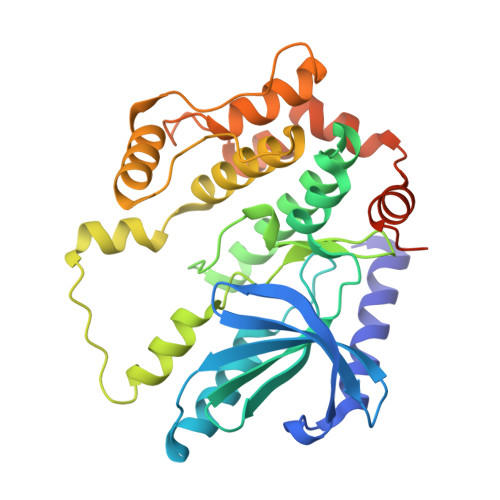Qualitative differences in disease-associated MEK mutants reveal molecular signatures and aberrant signaling-crosstalk in cancer.
Kubota, Y., Fujioka, Y., Patil, A., Takagi, Y., Matsubara, D., Iijima, M., Momose, I., Naka, R., Nakai, K., Noda, N.N., Takekawa, M.(2022) Nat Commun 13: 4063-4063
- PubMed: 35831322
- DOI: https://doi.org/10.1038/s41467-022-31690-w
- Primary Citation of Related Structures:
7F2X - PubMed Abstract:
Point-mutations of MEK1, a central component of ERK signaling, are present in cancer and RASopathies, but their precise biological effects remain obscure. Here, we report a mutant MEK1 structure that uncovers the mechanisms underlying abnormal activities of cancer- and RASopathy-associated MEK1 mutants. These two classes of MEK1 mutations differentially impact on spatiotemporal dynamics of ERK signaling, cellular transcriptional programs, gene expression profiles, and consequent biological outcomes. By making use of such distinct characteristics of the MEK1 mutants, we identified cancer- and RASopathy-signature genes that may serve as diagnostic markers or therapeutic targets for these diseases. In particular, two AKT-inhibitor molecules, PHLDA1 and 2, are simultaneously upregulated by oncogenic ERK signaling, and mediate cancer-specific ERK-AKT crosstalk. The combined expression of PHLDA1/2 is critical to confer resistance to ERK pathway-targeted therapeutics on cancer cells. Finally, we propose a therapeutic strategy to overcome this drug resistance. Our data provide vital insights into the etiology, diagnosis, and therapeutic strategy of cancers and RASopathies.
- Division of Cell Signaling and Molecular Medicine, Institute of Medical Science, The University of Tokyo, Minato-ku, Tokyo, 108-8639, Japan.
Organizational Affiliation:

















